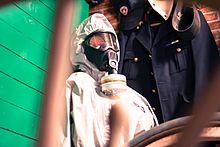Difference between revisions of "Personal protective equipment"
(Created page with "As working with chemicals can be hazardous, as most are either toxic or stain, it's best to follow all the protection steps, including wearing proper protection. ==Personal p...") |
|||
| Line 33: | Line 33: | ||
Aprons can be found at hardware stores. | Aprons can be found at hardware stores. | ||
| + | |||
| + | ==References== | ||
| + | <references/> | ||
| + | ===Relevant Sciencemadness threads=== | ||
| + | |||
| + | [[Category:Lab safety]] | ||
Revision as of 16:16, 7 September 2015
As working with chemicals can be hazardous, as most are either toxic or stain, it's best to follow all the protection steps, including wearing proper protection.
Contents
Personal protective equipment
Personal protective equipment, or PPE, as it it more commonly abbreviated, is any class of protective equipment that is used to protect the user's body from injury. The type of protective equipment used depends on the specific hazards faced during the experiment, however, commonly used PPE used in a home laboratory environment include a lab coat, chemical resistant goggles, long pants and covered shoes.
Potential hazards
Particulate matter/Chemical vapor
Respirators protect personnel from inhaling harmful dust, powders and vapors. These hazards can come about from weighing out finely divided powders which can cause Pneumoconiosis, inhalation of harmful chemical vapors can cause acute inhalation injuries such as chemical pneumonitis.
To prevent this, simple steps can be taken to ensure a safe working environment, such as providing adequate ventilation, and wearing a dust mask, which can filter out most particulate matter from the environment. For harmful chemical fumes, a respirator is advised, if not working in a fume hood or adequately ventilated area, with the proper chemical absorbent cartridges to be used for the specific hazard. Respirator manufacturers usually have a list of which chemical cartridges for use with what chemicals. Do note that these types of respirators, are known as air purifying respirators (APR) and do not provide supplemental oxygen to the user, thus, these should not be used for oxygen deficient environments (<19.5%) or in environments deemed immediately dangerous to life or health (IDLH).
In IDLH enviroments, an air supply external to the enviroment should be used, either a supplied air system with the air source downwind of the working enviroment and placed away from any other sources of air contamination (generators .etc), or a self contained beathing apparatus (SCBA) is to be used with an adequate supply of air, taking into account any additional time required for decontamination (if necessary).
Skin protection
Skin protection includes equipment such as gloves, chemical resistant goggles, a lab coat, long pants and covered shoes, these material while not chemical resistant, giver the user sufficient time to and get to a safety shower should a large spill occur, and get rid of any contaminated clothing.
Gloves are used when handling hazardous chemicals. Nitrile gloves are resistant against a wider range of chemicals as compared to latex gloves, nitrile gloves can also be used for people with latex allergies. There are also butyl rubber gloves that can be used dependent on the situation. One should check the permeation time of the gloves if working with the chemical for an extended period of time.
Lab coats are long sleeved, knee length overcoats usually made of cotton, linen, or cotton polyester blend, to enable it to be washed at high temperatures. It serves as a primary form of protection against chemical spillage.
Goggles are important in the lab to protect the eyes against hazardous chemicals, they prevent accidental splashes from blinding the user, pair of polycarbonate lensed goggles are preferred over safety glasses as they provide better protection. Polycarbonate lensed goggles are preferred as it is impact resistant, in case of broken glassware, also, polycarbonate is reasonably UV opaque and will prevent UV damage to the eyes, if working with a UV light source.
If a higher level of protection is required, a chemical resistant suit can be used. These suits are usually made of materials like Tyvek, Teflon, rubber and heavy PVC or other impermeable full body barrier material. The different chemical suits have different levels of protection, with level A being fully encapsulated gas tight suits while level B suits have no vapor protection, while still requiring SCBA and level C suits have the same type of protection of a level B garment, however a SCBA is not required and can be substituted for an air purifying respirator.
Acquisition of personal protective equipment
Lab coats can be bought at many university campuses as well many medical supplies stores. Sometime they can be found at second-hand clothing stores.
Nitrile and latex gloves can be bought at many pharmacies and hospitals as well as medical supplies stores.
Safety goggles/glasses can be bought at hardware stores.
Gas masks, such as the dust variety, with/without filter can be found at hardware stores, usually at the construction/paint section. Larger varieties can be found at military shops or online.
Aprons can be found at hardware stores.
